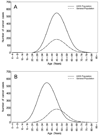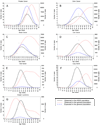Age at cancer diagnosis among persons with AIDS in the United States
- PMID: 20921544
- PMCID: PMC3071616
- DOI: 10.7326/0003-4819-153-7-201010050-00008
Age at cancer diagnosis among persons with AIDS in the United States
Abstract
Background: Studies have reported young ages at cancer diagnosis in HIV-infected persons and have suggested that HIV accelerates carcinogenesis. However, these comparisons did not account for differences in population age structures.
Objective: To compare ages at diagnosis for non-AIDS-defining types of cancer that occur in both the AIDS and general populations, after adjustment for differences in age and other demographic characteristics between these populations.
Design: Registry linkage study.
Setting: 15 HIV/AIDS and cancer registry databases in the United States.
Participants: 212 055 persons with AIDS enrolled in the U.S. HIV/AIDS Cancer Match Study from 1996 to 2007.
Measurements: Comparison of age-at-diagnosis distributions for various types of cancer in both the AIDS and general populations, after adjustment for age and other demographic characteristics.
Results: The proportion of person-time contributed by older persons (age ≥65 years) was far smaller in the AIDS population (1.5%) than in the general population (12.5%). Reflecting this difference, the ages at diagnosis for most types of cancer were approximately 20 years younger among persons with AIDS. However, after adjustment for differences in the populations at risk, the median ages at diagnosis in the AIDS and general populations did not differ for most types of cancer (for example, colon, prostate, or breast cancer; all P > 0.100). In contrast, ages at diagnosis of lung (median, 50 vs. 54 years) and anal cancer (median, 42 vs. 45 years) were significantly younger in persons with AIDS than expected in the general population (P < 0.001), and the age at diagnosis of Hodgkin lymphoma was significantly older (median, 42 vs. 40 years; P < 0.001).
Limitations: Information on other cancer risk factors, including cigarette smoking, was not available. Analysis was restricted to non-Hispanic white and black persons who had AIDS, which could limit the generalizability of the findings to other racial and ethnic groups or to persons with HIV but not AIDS.
Conclusion: For most types of cancer, the age at diagnosis is similar in the AIDS and general populations, after adjustment for the ages of the populations at risk. Modest age differences remained for a few types of cancer, which may indicate either acceleration of carcinogenesis by HIV or earlier exposure to cancer risk factors.
Primary funding source: National Cancer Institute.
Figures



Comment in
-
HIV and premature aging: A field still in its infancy.Ann Intern Med. 2010 Oct 5;153(7):477-9. doi: 10.7326/0003-4819-153-7-201010050-00013. Ann Intern Med. 2010. PMID: 20921548 No abstract available.
-
Age at cancer diagnosis among persons with AIDS.Ann Intern Med. 2011 May 3;154(9):642-3; author reply 643. doi: 10.7326/0003-4819-154-9-201105030-00013. Ann Intern Med. 2011. PMID: 21536942 No abstract available.
-
Age at cancer diagnosis among persons with AIDS.Ann Intern Med. 2011 May 3;154(9):642; author reply 643. doi: 10.7326/0003-4819-154-9-201105030-00012. Ann Intern Med. 2011. PMID: 21536943 No abstract available.
Summary for patients in
-
Summaries for patients. Do persons with AIDS develop common types of cancer at younger ages?Ann Intern Med. 2010 Oct 5;153(7):I48. doi: 10.7326/0003-4819-153-7-201010050-00004. Ann Intern Med. 2010. PMID: 20921539 No abstract available.
References
-
- Centers for Disease Control and Prevention. 1993 revised classification system for HIV infection and expanded surveillance case definition for AIDS among adolescents and adults. MMWR Recomm Rep. 1992;41(RR-17):1–19. - PubMed
-
- Engels EA, Pfeiffer RM, Goedert JJ, Virgo P, McNeel TS, Scoppa SM, et al. Trends in cancer risk among people with AIDS in the United States 1980–2002. AIDS. 2006;20(12):1645–1654. - PubMed
-
- Engels EA, Biggar RJ, Hall HI, Cross H, Crutchfield A, Finch JL, et al. Cancer risk in people infected with human immunodeficiency virus in the United States. Int J Cancer. 2008;123(1):187–194. - PubMed
-
- Patel P, Hanson DL, Sullivan PS, Novak RM, Moorman AC, Tong TC, et al. Incidence of Types of Cancer among HIV-Infected Persons Compared with the General Population in the United States, 1992 . Annals of internal medicine. 2008;148(10):728–736. - PubMed
Publication types
MeSH terms
Grants and funding
LinkOut - more resources
Full Text Sources
Medical
